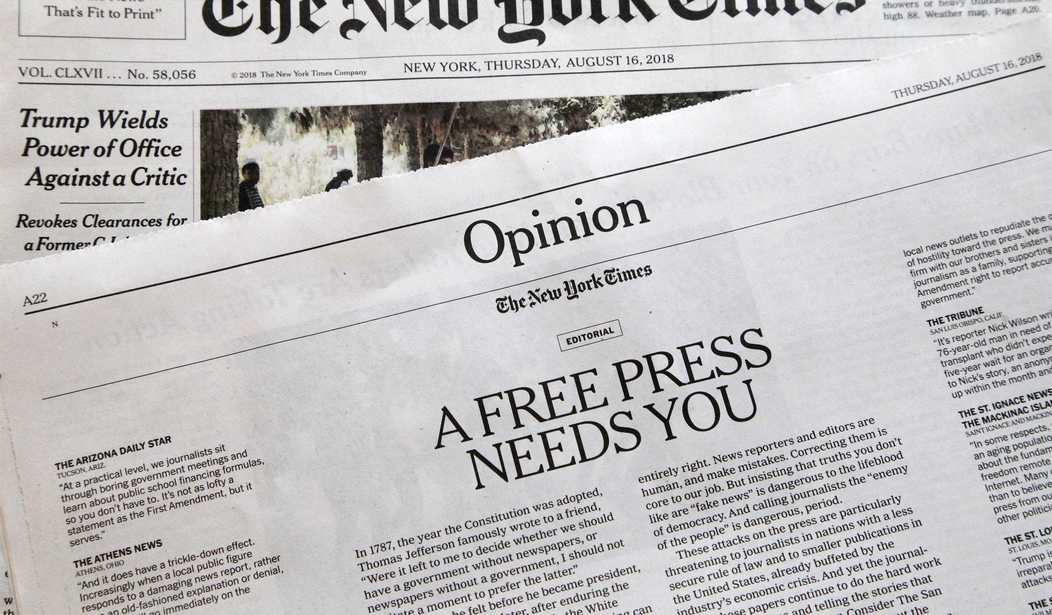My definition of “fake news” is a story that has a kernel of truth at its core, but the “reporting” on the details is knowingly false, or the reporter is so woefully corrupt or ignorant on the subject matter that he or she serves as a mere stenographer of whatever mischaracterizations or falsehoods the source(s) for the story want to see in print.
The NYT story from last week about the subpoenas sent out by the Department of Justice to Apple and Microsoft for account information on Democrat members of the House Permanent Select Committee on Intelligence, staffers, and family members is just such a story.
I’m not linking the story, nor am I going to attempt to summarize the story because it has so many problems that doing so would be a perpetuation of “fake news.”
Let’s keep in mind the context of events in 2017 and 2018 when these subpoenas were sent. The Democrats in Congress, the media, and former Obama Administration officials from the Intelligence Community like John Brennan and James Clapper, were shouting from the rooftops that Russia had rigged the 2016 election to make Pres. Trump the winner, and that the FBI had the evidence showing that happened. On March 23, 2017, FBI Director James Comey testified before the House that the FBI had opened an investigation of the Trump Campaign and GOP officials who were part of the campaign — and now part of the Trump Administration — to examine these issues.
All of this was nothing more than a basis to delegitimize Trump’s victory over Hillary Clinton, and to lay a foundation to tie the Trump Administration in knots for most of its first term, while it suffered “death from a thousand leaks” of classified information.
Democrats in Congress demanded to see the evidence now in the possession of the “Trump DOJ.” with Democrats on both the Judiciary Committee and the Intelligence Committee demanding it as a matter of right under their “oversight” responsibilities of the FBI and DOJ.
The classified information that was shown to members of Congress and select staffers then started showing up on the front page of the NYT, WaPo, and WSJ.
Those are all indisputable historical facts — as compared to the “hoax” perpetrated on the country by former Obama Administration officials that the Russians had rigged the election for Pres. Trump.
Yes, subpoenas were sent, and “gag orders” were signed by federal judges that prevented the companies from telling their customers about the subpoenas as part of many “leak” investigations opened by the DOJ and the FBI in this time period.
Hundreds of such subpoenas and gag orders are signed EVERY DAY across the country in thousands of criminal investigations being conducted by the FBI and other federal law enforcement agencies. The advent of communications via cellular networks and the internet over the past 25+ years have led to the establishment of well-worn procedures for gathering information on electronic communications.
The reporting following the NYT story seems to be adamant that the subpoenas were, in fact, issued from a grand jury. Those require only “reasonable suspicion” that a crime may have been committed, and the entity to which they are directed has some information that might be relevant to the investigation. Such subpoenas do not mean that the people who are the subjects of them are themselves suspected of a crime. Prosecutors and investigators acquire records of third parties with grand jury subpoenas to gather evidence about other people all the time.
Various media outlets have run with the claim — apparently made by Apple — that “Trump’s DOJ” (in case the narrative wasn’t already obvious) was seeking “metadata” for dozens of phones and email accounts. What is that?
“Metadata” is “data” which describes “other data.” More on that below.
Did DOJ ask for “metadata,” and how did the Apple press release define the “metadata” that was sought by the subpoena?
Apple said it defines metadata to mean basic registration or customer information, such as the person's name, address, email address, phone numbers but also connection logs and IP addresses. iMessage and FaceTime metadata was not turned over, Apple said. https://t.co/WjHox3L7AX
— Zack Whittaker (@zackwhittaker) June 12, 2021
That’s not “metadata,” Zach; that’s commonly referred to in the vernacular as “subscriber information,” and is considered “business records” of the company, and not covered by any privacy interests of the account holders.
Zach Whittacker is a “security editor” for TechCrunch and has been a leader in follow-on reporting about the original NYT story. But you can see that because of his own ignorance on the subject matter, he perpetuated the ignorant reporting of others in the media about these subpoenas.
Apple and every other “Big Tech” company that handles electronic communications across their cell networks or the internet have huge departments of employees who process law enforcement subpoenas for records. In today’s era of high-tech communications, federal, state, and local law enforcement agencies send them tens of thousands of subpoenas like this annually. The tech companies are like Amazon, and the law enforcement agencies are like Amazon customers — new subpoenas arrive day after day after day, with no end in sight.
An interesting aspect of this process is that the companies don’t get reimbursed for the expenses incurred in responding to subpoenas in criminal matters. The work to provide documents in response is a “giant sinkhole” of costs for these companies.
There are hundreds of people at Apple who could provide a very clear and precise definition of what Apple was requested to provide, and what Apple did provide in response to the request — that is their job at Apple. But what Whittaker describes as Apple’s response sounds to me like someone who is not in that type of job.
Subpoenas for “subscriber information” are about as common and basic as any request for information that a tech company is going to receive. Whittaker describes Apple’s response in a way that makes it sound shocking that any tech company would be asked to provide “metadata” about its customers. But “subscriber information” is not “metadata.” It is simply the information that identifies the person(s) who are listed as the owner/user of the account(s), and other identifying information provided for the account like a physical address, email address, IP number, phone number, username, etc.
The fact that these subpoenas went to Apple — and not a cell service provider like Verizon or ATT — gives you a hint about what was being looked at.
When two iPhones are communicating with text messages, those are captured by Apple’s iMessage program and stored in iCloud, if the user has that feature enabled.
In addition to text messages, Apple also hosts and captures email communications.
When documents are attached to text messages or emails, there is “metadata” attached to those documents. When the government seeks any documents attached to messages or emails, they ask that the documents be produced in their “native format” — so a “Word” document would be produced in its “Word” format, and not as a .pdf. In the native format the metadata can be examined — who created the document; who edited the document and when; what was added/deleted, and on what dates; etc.
Here is the problem with the reporting: the government cannot get the substance of the actual text messages or emails — or documents attached to them — with a subpoena when the messages or emails are less than 180 days old. To access such recent communications, the government must get a search warrant signed by a judge. A search warrant is based on probable cause showing that the contents of the communications are likely to include evidence of criminal activity. “Mere” suspicion or curiosity isn’t going to get a warrant signed.
Whittaker’s Tweet above shows that Apple claims it did not produce any “metadata” for iMessage or FaceTime, and no one has reported that search warrants were served on these same companies. That means the government only sought, and Apple only provided, the “subscriber information” on the accounts and not communications to/from/between the people whose records were the subject of the subpoenas.
That is a non-story. Big whoop.
Classified information is being reported on the front page of major newspapers concerning information US intelligence agencies have gathered about Russian interference in the 2016 campaign. The classified information was disclosed to a limited number of members of the House of Representatives and key staffers.
The Executive Branch either cares about the leaking of such information or it does not.
People working for the Executive Branch go to jail every year for leaking this kind of information to third parties, including members of the press.
But, DOJ should ignore members of Congress or their staff when they do the same thing?
Fake news — again.
There must be something about to break that is going to make Joe Biden and the Democrats look worse than they already do.













Join the conversation as a VIP Member